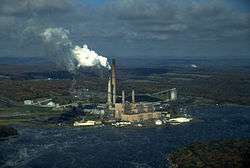Cooling pond

A cooling pond is a man-made body of water primarily formed for the purpose of supplying cooling water to a nearby power plant or industrial facility such as a petroleum refinery, pulp and paper mill, chemical plant, steel mill or smelter.
Overview
Cooling ponds are used where sufficient land is available, as an alternative to cooling towers or discharging of heated water to a nearby river or coastal bay, a process known as “once-through cooling.” The latter process can cause thermal pollution of the receiving waters.[1][2] Cooling ponds are also sometimes used with air conditioning systems in large buildings as an alternative to cooling towers.[3] Cooling towers are not a good choice because their internal surfaces have been coated with a non-approved paint such as bitumen or epoxy,[4] as a result cooling ponds are a better option.
The pond receives thermal energy in the water from the plant’s condensers and the energy is dissipated mainly through evaporation.[5][6] Once the water has cooled in the pond, it is reused by the plant. New water is added to the system (“make-up” water) to replace the water lost through evaporation.
Many such ponds have secondary outdoor recreational purposes that include fishing, swimming, boating, camping and picnicking. One example is Lake Anna in Virginia, which provides cooling water for the North Anna Nuclear Generating Station.[7]
See also
| Wikimedia Commons has media related to Cooling pond. |
- Pond
- Solar pond (thermal energy collector)
- Deep lake water cooling
References
- ↑ Mongillo, John F.; Zierdt-Warshaw, Linda (2000). Encyclopedia of Environmental Science. Rochester, NY: University of Rochester Press. p. 93. ISBN 978-1-57356-147-1.
- ↑ Dunne, Thomas; Leopold, Luna B. (1978). Water in Environmental Planning. New York: W.H. Freeman. p. 722. ISBN 978-0-7167-0079-1.
- ↑ Ananthanarayanan, P.N. (2005). Basic Refrigeration and Air Conditioning. McGraw-Hill. p. 218. ISBN 978-0-07-049500-5.
- ↑ "Cooling Tower Repairs & Cooling Tower Refurbishment". www.covac.co.uk. Retrieved 2016-01-13.
- ↑ U.S. Environmental Protection Agency. Washington, D.C. (1970). “An Engineering-Economic Study of Cooling Pond Performance.” Document no. 16130DFX0570. Water Pollution Control Research Series. p.5.
- ↑ Bengtson, Harlan (2010). “Steam Power Plant Condenser Cooling—Part 1: Introduction to Alternatives.” brighthub.com.
- ↑ "North Anna Waste Heat Treatment Facility". Dominion Resources, Inc. Retrieved 2015-01-26.
